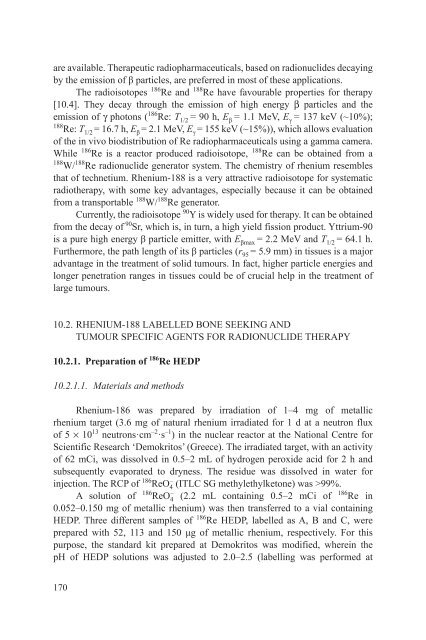Yttrium-90 and Rhenium-188 Radiopharmaceuticals for Radionuclide Therapy
Pub1662web-89688003
Pub1662web-89688003
Create successful ePaper yourself
Turn your PDF publications into a flip-book with our unique Google optimized e-Paper software.
are available. Therapeutic radiopharmaceuticals, based on radionuclides decaying<br />
by the emission of β particles, are preferred in most of these applications.<br />
The radioisotopes 186 Re <strong>and</strong> <strong>188</strong> Re have favourable properties <strong>for</strong> therapy<br />
[10.4]. They decay through the emission of high energy β particles <strong>and</strong> the<br />
emission of γ photons ( 186 Re: T 1/2 = <strong>90</strong> h, E β = 1.1 MeV, E γ = 137 keV (~10%);<br />
<strong>188</strong> Re: T 1/2 = 16.7 h, E β = 2.1 MeV, E γ = 155 keV (~15%)), which allows evaluation<br />
of the in vivo biodistribution of Re radiopharmaceuticals using a gamma camera.<br />
While 186 Re is a reactor produced radioisotope, <strong>188</strong> Re can be obtained from a<br />
<strong>188</strong> W/ <strong>188</strong> Re radionuclide generator system. The chemistry of rhenium resembles<br />
that of technetium. <strong>Rhenium</strong>-<strong>188</strong> is a very attractive radioisotope <strong>for</strong> systematic<br />
radiotherapy, with some key advantages, especially because it can be obtained<br />
from a transportable <strong>188</strong> W/ <strong>188</strong> Re generator.<br />
Currently, the radioisotope <strong>90</strong> Y is widely used <strong>for</strong> therapy. It can be obtained<br />
from the decay of <strong>90</strong> Sr, which is, in turn, a high yield fission product. <strong>Yttrium</strong>-<strong>90</strong><br />
is a pure high energy β particle emitter, with E βmax = 2.2 MeV <strong>and</strong> T 1/2 = 64.1 h.<br />
Furthermore, the path length of its β particles (r 95 = 5.9 mm) in tissues is a major<br />
advantage in the treatment of solid tumours. In fact, higher particle energies <strong>and</strong><br />
longer penetration ranges in tissues could be of crucial help in the treatment of<br />
large tumours.<br />
10.2. RHENIUM-<strong>188</strong> LABELLED BONE SEEKING AND<br />
TUMOUR SPECIFIC AGENTS FOR RADIONUCLIDE THERAPY<br />
10.2.1. Preparation of 186 Re HEDP<br />
10.2.1.1. Materials <strong>and</strong> methods<br />
<strong>Rhenium</strong>-186 was prepared by irradiation of 1–4 mg of metallic<br />
rhenium target (3.6 mg of natural rhenium irradiated <strong>for</strong> 1 d at a neutron flux<br />
of 5 × 10 13 neutrons·cm –2·s–1 ) in the nuclear reactor at the National Centre <strong>for</strong><br />
Scientific Research ‘Demokritos’ (Greece). The irradiated target, with an activity<br />
of 62 mCi, was dissolved in 0.5–2 mL of hydrogen peroxide acid <strong>for</strong> 2 h <strong>and</strong><br />
subsequently evaporated to dryness. The residue was dissolved in water <strong>for</strong><br />
injection. The RCP of 186 ReO – 4 (ITLC SG methylethylketone) was >99%.<br />
A solution of 186 –<br />
ReO 4 (2.2 mL containing 0.5–2 mCi of 186 Re in<br />
0.052–0.150 mg of metallic rhenium) was then transferred to a vial containing<br />
HEDP. Three different samples of 186 Re HEDP, labelled as A, B <strong>and</strong> C, were<br />
prepared with 52, 113 <strong>and</strong> 150 μg of metallic rhenium, respectively. For this<br />
purpose, the st<strong>and</strong>ard kit prepared at Demokritos was modified, wherein the<br />
pH of HEDP solutions was adjusted to 2.0–2.5 (labelling was per<strong>for</strong>med at<br />
170




